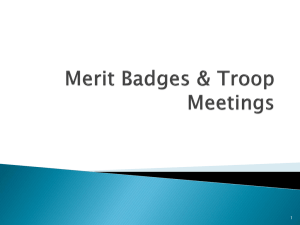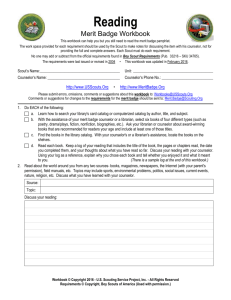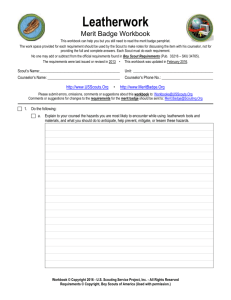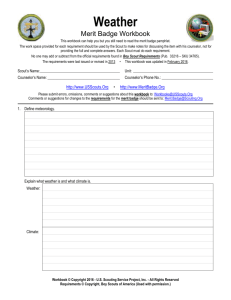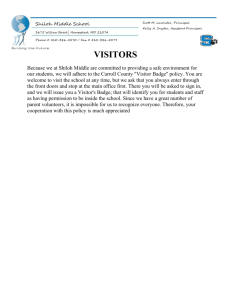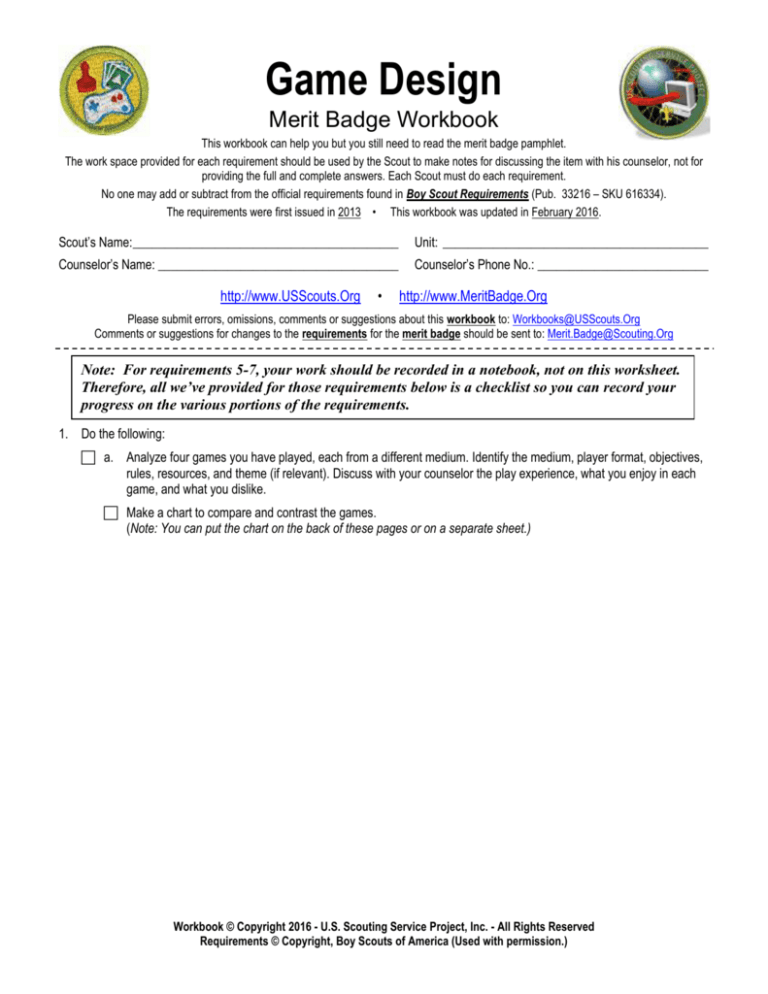
Game Design
Merit Badge Workbook
This workbook can help you but you still need to read the merit badge pamphlet.
The work space provided for each requirement should be used by the Scout to make notes for discussing the item with his counselor, not for
providing the full and complete answers. Each Scout must do each requirement.
No one may add or subtract from the official requirements found in Boy Scout Requirements (Pub. 33216 – SKU 616334).
The requirements were first issued in 2013 • This workbook was updated in February 2016.
Scout’s Name:__________________________________________
Unit: __________________________________________
Counselor’s Name: ______________________________________
Counselor’s Phone No.: ___________________________
http://www.USScouts.Org
•
http://www.MeritBadge.Org
Please submit errors, omissions, comments or suggestions about this workbook to: Workbooks@USScouts.Org
Comments or suggestions for changes to the requirements for the merit badge should be sent to: Merit.Badge@Scouting.Org
Note: For requirements 5-7, your work should be recorded in a notebook, not on this worksheet.
Therefore, all we’ve provided for those requirements below is a checklist so you can record your
progress on the various portions of the requirements.
1. Do the following:
a. Analyze four games you have played, each from a different medium. Identify the medium, player format, objectives,
rules, resources, and theme (if relevant). Discuss with your counselor the play experience, what you enjoy in each
game, and what you dislike.
Make a chart to compare and contrast the games.
(Note: You can put the chart on the back of these pages or on a separate sheet.)
Workbook © Copyright 2016 - U.S. Scouting Service Project, Inc. - All Rights Reserved
Requirements © Copyright, Boy Scouts of America (Used with permission.)
Game Design
Scout's Name: ________________________
Game 1
Medium
Player Format
Objectives
Rules
Resources
Theme
Discuss the play experience, what you enjoy and what you dislike.
Game Design - Merit Badge Workbook
Page. 2 of 16
Game Design
Scout's Name: ________________________
Game2
Medium
Player Format
Objectives
Rules
Resources
Theme
Discuss the play experience, what you enjoy and what you dislike.
Game Design - Merit Badge Workbook
Page. 3 of 16
Game Design
Scout's Name: ________________________
Game 3
Medium
Player Format
Objectives
Rules
Resources
Theme
Discuss the play experience, what you enjoy and what you dislike.
Game Design - Merit Badge Workbook
Page. 4 of 16
Game Design
Scout's Name: ________________________
Game 4
Medium
Player Format
Objectives
Rules
Resources
Theme
Discuss the play experience, what you enjoy and what you dislike.
Game Design - Merit Badge Workbook
Page. 5 of 16
Game Design
Scout's Name: ________________________
b. Describe four types of play value and provide an example of a game built around each concept.
Type of Play Value
Example
1
2.
3.
4.
Discuss other reasons people play games.
2. Discuss with your counselor five of the following 17 game design terms. For each term that you pick, describe how it relates
to a specific game.
Thematic game elements:
story,
setting,
characters
Game Design - Merit Badge Workbook
Page. 6 of 16
Game Design
Scout's Name: ________________________
Gameplay elements:
play sequence,
level design,
interface design
Game analysis:
difficulty,
balance,
depth,
Game Design - Merit Badge Workbook
Page. 7 of 16
Game Design
Scout's Name: ________________________
pace,
replay value,
age appropriateness
Related terms:
single-player vs. multiplayer,
cooperative vs. competitive,
turn-based vs. real-time,
Game Design - Merit Badge Workbook
Page. 8 of 16
Game Design
Scout's Name: ________________________
strategy vs. reflex vs. chance,
abstract vs. thematic
3. Define the term intellectual property.
Describe the types of intellectual property associated with the game design industry.
Describe how intellectual property is protected and why protection is necessary.
Define and give an example of a licensed property.
Game Design - Merit Badge Workbook
Page. 9 of 16
Game Design
Scout's Name: ________________________
4. Do the following:
a. Pick a game where the players can change the rules or objectives (examples: basketball, hearts, chess, kickball).
Game: ______________________________________________________________________________________
Briefly summarize the standard rules and objectives and play through the game normally.
b. Propose changes to several rules or objectives.
Predict how each change will affect gameplay.
c. Play the game with one rule or objective change, observing how the players’ actions and emotional experiences are
affected by the rule change.
Rule Change:
Observations:
Repeat this process with two other changes.
Game Design - Merit Badge Workbook
Page. 10 of 16
Game Design
Scout's Name: ________________________
Rule Change 2:
Observations:
Rule Change 3:
Observations:
b. Explain to your counselor how the changes affected the actions and experience of the players.
Discuss the accuracy of your predictions.
5. Design a new game. Any game medium or combination of mediums is acceptable. Record your work in a game design
notebook.
a. Write a vision statement for your game.
Identify the medium, player format, objectives, and theme of the game. If suitable, describe the setting, story, and
characters.
b. Describe the play value.
Game Design - Merit Badge Workbook
Page. 11 of 16
Game Design
Scout's Name: ________________________
c. Make a preliminary list of the rules of the game. Define the resources.
d. Draw the game elements.
6. Do the following:
a. Prototype your game from requirement 5. If applicable, demonstrate to your counselor that you have addressed
player safety through the rules and equipment.
You must have your merit badge counselor’s approval of your concept before you begin creating the
prototype.
b. Test your prototype with as many other people as you need to meet the player format.
Compare the play experience to your descriptions from requirement 5b.
Correct unclear rules, holes in the rules, dead ends, and obvious rule exploits.
Change at least one rule, mechanic, or objective from your first version of the game, and describe why you are
making the change.
Play the game again.
Record whether or not your change had the expected effect.
c. Repeat 6b at least two more times.
First repetition:
Test your prototype with as many other people as you need to meet the player format.
Compare the play experience to your descriptions from requirement 5b.
Correct unclear rules, holes in the rules, dead ends, and obvious rule exploits.
Change at least one rule, mechanic, or objective from your first version of the game, and describe why you are
making the change.
Play the game again.
Record whether or not your change had the expected effect.
Second repetition:
Test your prototype with as many other people as you need to meet the player format.
Compare the play experience to your descriptions from requirement 5b.
Correct unclear rules, holes in the rules, dead ends, and obvious rule exploits.
Change at least one rule, mechanic, or objective from your first version of the game, and describe why you are
making the change.
Play the game again.
Record whether or not your change had the expected effect.
7. Blind test your game. Do the following:
a. Write an instruction sheet that includes all of the information needed to play the game.
Clearly describe how to set up the game, play the game, and end the game.
List the game objectives.
b. Share your prototype from requirement 6a with a group of players that has not played it or witnessed a previous
playtest.
Game Design - Merit Badge Workbook
Page. 12 of 16
Game Design
Scout's Name: ________________________
Provide them with your instruction sheet(s) and any physical components.
Watch them play the game, but do not provide them with instruction.
Record their feedback in your game design notebook.
c. Share your game design notebook with your counselor.
Discuss the player reactions to your project and what you learned about the game design process.
Based on your testing, determine what you like most about your game and suggest one or more changes.
8. Do ONE of the following:
a. With your parent’s permission and your counselor’s approval, visit with a professional in the game development
industry and ask him or her about his or her job and how it fits into the overall development process. Alternately,
meet with a professional in game development education and discuss the skills he or she emphasizes in the
classroom.
Game Design - Merit Badge Workbook
Page. 13 of 16
Game Design
Scout's Name: ________________________
b. List three career opportunities in game development
1.
2.
3.
Pick one and find out the education, training, and experience required for this profession.
Career:______________________________________________________________________________________
Education:
Training:
Experience:
Discuss this with your counselor. Explain why this profession might interest you
Requirement resources can be found here:
http://www.meritbadge.org/wiki/index.php/Game Design#Requirement resources
Game Design - Merit Badge Workbook
Page. 14 of 16
Note to the Counselor:
The project portion of the Game Design merit badge gives Scouts flexibility to work with a medium of their choosing.
The level of effort required to make a game in different mediums can vary significantly. However, the requirements
define what each Scout must include in his design notebook so that there is a baseline for all Scouts to meet.
The notebook must demonstrate a thoughtful initial concept, multiple design iterations based on initial testing, and
feedback from blind testing. Encourage Scouts to use their notebook to record brainstorming sessions, test
parameters, and any game-related ideas throughout the process. Also encourage them to record thoughts behind key
design decisions to help them trace and retrace their steps as their designs evolve.
Before a Scout begins the prototyping phase, he must have counselor approval for his design concept. The counselor
must make sure that he has put enough effort into the concept phase to have a good foundation for the prototype
phase. Watch out for overly ambitious projects that could lead to unnecessary frustration. It is important to understand
that the Scout is making a prototype. The challenge of the project is to develop and experiment with gameplay, not to
develop extensive programming skills, create beautiful artwork, or spend a lot of time fabricating components.
When prototyping, Scouts should devote most of their energy to assessing and improving the play experience. With
each iteration, Scouts should identify game elements that they want to change and how the changes will alter the play
experience. After making changes, they then test the game and evaluate whether or not the changes had the desired
outcome. It is acceptable for the final prototype to be very different from the initial concept, provided that the notebook
shows the progression.
Because the project is so flexible, it is likely that you will have Scouts working in mediums with which you are
unfamiliar. The game design community has a vast array of publicly available resources, and the merit badge
information online at www.scouting.org maintains updated links to relevant material. If you have a specific concern
about programming an electronic game prototype, there are a number of free or inexpensive game design software
packages available online. Some are very easy to use with little or no computer knowledge, and most have robust
information resources to support them. See the resources section at the end of (the) pamphlet.
The merit badge includes many opportunities for teamwork and group play. Group participation is mandatory to
complete requirement 7, but all of the other nonproject requirements also work well in collaboration. Note, though, that
each Scout must deliver his own game prototype to complete the project. This ensures that every Scout has the
chance to develop and use the critical thinking skills that are part of testing and design iteration. If they want to
collaborate on their projects after completing the requirements for the badge they are encouraged to do so, but that is
beyond the scope of this badge.
The Game Design merit badge relies heavily on specific terminology. Because game design is broad and game
analysis is relatively young, there are few established definitions in the industry. Please refer to the glossary at the end
of (the) pamphlet for definitions applicable to the pamphlet and requirements. For additional questions, refer to the
merit badge website and the resources listed at the end of the pamphlet.
Page. 15 of 16
Important excerpts from the Guide To Advancement - 2013, No. 33088 (SKU-618673)
[1.0.0.0] — Introduction
The current edition of the Guide to Advancement is the official source for administering advancement in all Boy Scouts of America programs: Cub
Scouting, Boy Scouting, Varsity Scouting, Venturing, and Sea Scouts. It replaces any previous BSA advancement manuals, including Advancement
Committee Policies and Procedures, Advancement and Recognition Policies and Procedures, and previous editions of the Guide to Advancement.
[Page 2, and 5.0.1.4] — Policy on Unauthorized Changes to Advancement Program
No council, committee, district, unit, or individual has the authority to add to, or subtract from, advancement requirements. There are limited
exceptions relating only to youth members with special needs. For details see section 10, “Advancement for Members With Special Needs”.
[Page 2] — The “Guide to Safe Scouting” Applies
Policies and procedures outlined in the Guide to Safe Scouting, No. 34416, apply to all BSA activities, including those related to advancement and
Eagle Scout service projects.
[7.0.3.1] — The Buddy System and Certifying Completion
A youth member must not meet one-on-one with an adult. Sessions with counselors must take place where others can view the interaction, or the
Scout must have a buddy: a friend, parent, guardian, brother, sister, or other relative—or better yet, another Scout working on the same badge—along
with him attending the session.
When the Scout meets with the counselor, he should bring any required projects. If these cannot be transported, he should present evidence, such as
photographs or adult verification. His unit leader, for example, might state that a satisfactory bridge or tower has been built for the Pioneering merit
badge, or that meals were prepared for Cooking. If there are questions that requirements were met, a counselor may confirm with adults involved.
Once satisfied, the counselor signs the blue card using the date upon which the Scout completed the requirements, or in the case of partials, initials
the individual requirements passed.
Note that from time to time, it may be appropriate for a requirement that has been met for one badge to also count for another. See “Fulfilling More
Than One Requirement With a Single Activity,” 4.2.3.6.
[7.0.3.2] — Group Instruction
It is acceptable—and sometimes desirable—for merit badges to be taught in group settings. This often occurs at camp and merit badge midways or
similar events. Interactive group discussions can support learning. The method can also be attractive to “guest experts” assisting registered and
approved counselors. Slide shows, skits, demonstrations, panels, and various other techniques can also be employed, but as any teacher can attest,
not everyone will learn all the material.
There must be attention to each individual’s projects and his fulfillment of all requirements. We must know that every Scout —actually and
personally— completed them. If, for example, a requirement uses words like “show,” “demonstrate,” or “discuss,” then every Scout must do that. It is
unacceptable to award badges on the basis of sitting in classrooms watching demonstrations, or remaining silent during discussions.
It is sometimes reported that Scouts who have received merit badges through group instructional settings have not fulfilled all the requirements. To
offer a quality merit badge program, council and district advancement committees should ensure the following are in place for all group instructional
events.
Merit badge counselors are known to be registered and approved.
Any guest experts or guest speakers, or others assisting who are not registered and approved as merit badge counselors, do not accept the
responsibilities of, or behave as, merit badge counselors, either at a group instructional event or at any other time. Their service is temporary, not
ongoing.
Counselors agree not to assume prerequisites have been completed without some level of evidence that the work has been done. Pictures and
letters from other merit badge counselors or unit leaders are the best form of prerequisite documentation when the actual work done cannot be
brought to the camp or site of the merit badge event.
There is a mechanism for unit leaders or others to report concerns to a council advancement committee on summer camp merit badge programs,
group instructional events, and any other merit badge counseling issues—especially in instances where it is believed BSA procedures are not
followed. See “Reporting Merit Badge Counseling Concerns,” 11.1.0.0.
There must be attention to each individual’s projects and his fulfillment of all requirements. We must know that every Scout—actually and
personally—completed them.
[7.0.3.3] — Partial Completions
A Scout need not pass all the requirements of one merit badge with the same counselor. It may be that due to timing or location issues, etc., he must
meet with a different counselor to finish the badge. The Application for Merit Badge has a place to record what has been finished—a “partial.” In the
center section on the reverse of the blue card, the counselor initials for each requirement passed. In the case of a partial completion, the counselor
does not retain his or her portion of the card. A subsequent counselor may choose not to accept partial work, but this should be rare. A Scout, if he
believes he is being treated unfairly, may work with his unit leader to find another counselor. An example for the use of a signed partial would be to
take it to camp as proof of prerequisites. Partials have no expiration except the Scout’s 18th birthday. Units, districts, or councils shall not establish
other expiration dates for partial merit badges.
[7.0.4.8] — Unofficial Worksheets and Learning Aids
Worksheets and other materials that may be of assistance in earning merit badges are available from a variety of places including unofficial sources
on the Internet and even troop libraries. Use of these aids is permissible as long as the materials can be correlated with the current requirements that
Scouts must fulfill. Completing “worksheets” may suffice where a requirement calls for something in writing, but this would not work for a requirement
where the Scout must discuss, tell, show, or demonstrate, etc. Note that Scouts shall not be required to use these learning aids in order to complete a
merit badge.
Attachment
(NOTE: It is not necessary to print this page.)
Page 16 of 16


